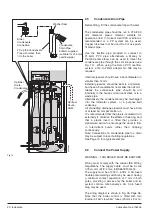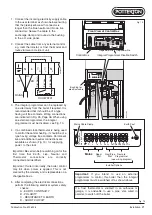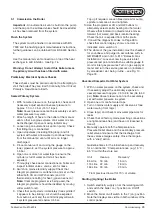
Publication No. 5106226
14
Installation Requirements
If the initial cold fill pressure is 1.0 bar:
expansion vessel size = 0.11 x system volume
This fill pressure will allow the maximum expansion
capacity, though any minor loss of water will result in
a rapid pressure drop. An additional expansion vessel
is only required if the total system volume exceeds
106 litres.
This includes the 5.5 litre primary circuit volume
within the Powermax HE boiler - thus radiator and
pipework volume should not exceed 100 litres.
Pipework above boiler
Air vents must be fitted at the highest positions on flow
and return pipes and at any point where air is likely to
collect.
TRV’s in System
An automatic bypass valve is built into the boiler to
allow thermostatic radiator valves to be fitted. This can
be switched into or out of circuit as required.
1.7
Discharge Pipework
It is a requirement of Building Regulation G3 that any
discharge from an unvented system is conveyed to
where it is visible, but will not cause danger to persons
in or about the building. The tundish and discharge
pipes should be fitted in accordance with the
requirements and guidance notes of Building
Regulation G3. The G3 Requirements and Guidance
section 3.9 are reproduced in the following sections.
Information Sheet No. 33 available from the British
Board of Agrement gives further advice on discharge
pipe installation. For discharge pipe arrangements not
covered by G3 Guidance or BBA Info Sheet No.33
advice should be sought from either your local Building
Control Officer or Potterton.
G3 Requirement
“...there shall be precautions ... to
ensure that the hot water discharged from safety
devices is safely conveyed to where it is visible but will
not cause danger to persons in or about the building.”
G3 Guidance SECTION 3.9
The discharge pipe (D1) from the vessel up to and
including the tundish is generally supplied by the
manufacturer of the hot water storage system. Where
otherwise, the installation should include the discharge
pipe(s) (D1) from the safety device(s). In either case the
tundish should be vertical, located in the same space
as the unvented hot water storage system and be fitted
as close as possible and within 500 mm of the safety
device e.g. the temperature relief valve.
Note:
The
tundish is factory fitted during manufacture of the
Powermax HE
. The discharge pipe (D2) from the
tundish should terminate in a safe place where there is
no risk to persons in the vicinity of the discharge,
preferably be of metal and:
a.be at least one pipe size larger than the nominal
outlet size of the safety device unless its total
equivalent hydraulic resistance exceeds that of a
straight pipe 9m long i.e. discharge pipes between 9m
and 18m equivalent resistance length should be at
least two sizes larger than the nominal Outlet size of
the safety device, between 18 and 27m at least 3 sizes
larger, and so on. Bends must be taken into account in
calculating the flow resistance. Refer to Fig. 7, Table 1
and the worked example.
An alternative approach for sizing discharge pipes
would be to follow BS 6700:1987 Specification for
design installation, testing and maintenance of
services supplying water for domestic use within
buildings and their curtilages. Appendix E. section E2
and table 21.
b. have a vertical section of pipe at least 300 mm long,
below the tundish before any elbows or bends in the
pipework.
c. be installed with a continuous fall.
d.have discharges visible at both the tundish and the
final point of discharge, but where this is not possible
or practical, there should be clear visibility at one or
other of these locations. Examples of acceptable
discharge arrangements are:
i. ideally below a fixed grating and above the water
seal in a trapped gully.
ii. downward discharges at low level; i.e. up to
100mm above external surfaces such as car
parks, hard standings, grassed areas etc. are
acceptable providing that where children may
play or otherwise come into contact with
discharges a wire cage or similar guard is
positioned to prevent contact, whilst maintaining
visibility.
iii. discharges at high level; e.g. into a metal hopper
and metal down pipe with the end of the
discharge pipe clearly visible (tundish visible or
not) or onto a roof capable of withstanding high
temperature discharges of water and 3m from
any plastic guttering system that would collect
such discharges (tundish visible).
iv. where a single pipe serves a number of
discharges, such as in blocks of flats, the number
served should be limited to not more than 6
systems so that any installation discharging can
be traced reasonably easily. The single common
discharge pipe should be at least one pipe size
larger than the largest individual discharge pipe
(D2) to be connected. If unvented hot water
storage systems are installed where discharges
from safety devices may not be apparent i.e. in





























